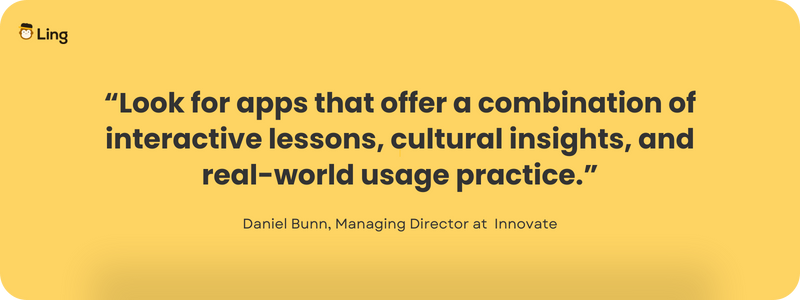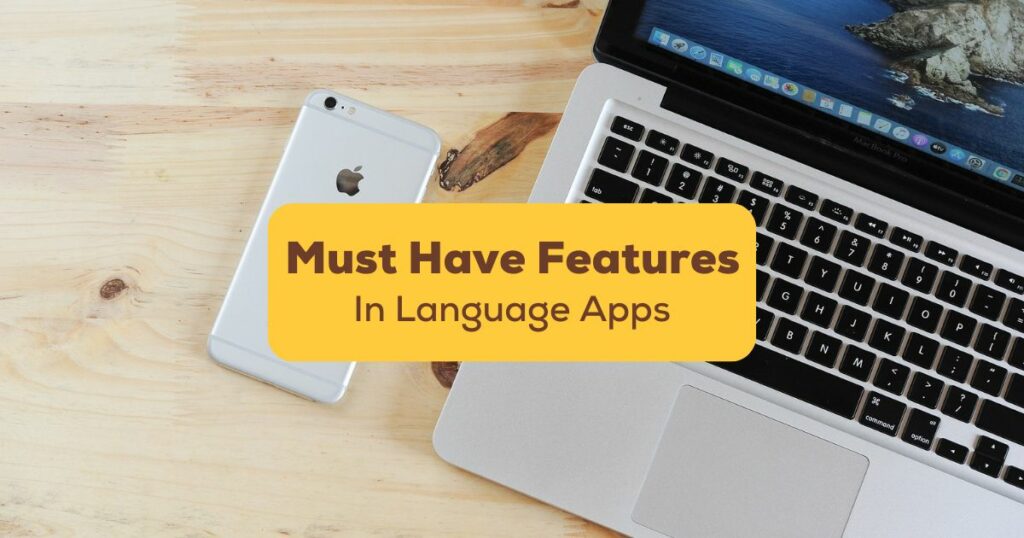As a language enthusiast (and certified yapper), I’m always looking for words and phrases in different languages to add to my vocabulary to connect with people in conversations. When I hear a word in a foreign language with an interesting meaning, especially those that are unique to the language and can’t be translated, I tend to write it down in a tiny notebook, repeat it every day, and do my best to commit it to memory.
Trying to learn an entirely new language can be scary. There’s so many options out there! From taking private classes to teaching yourself through watching YouTube videos or writing down random foreign words (ahem, guilty!) and sorting through a million language learning apps to choose from, where do you even begin? We’ll find the answer to that in this blog post. Read on!
Table Of Contents
Why Choose A Language Learning App?
A study from Michigan State University highlighted the concept of using a language learning app to improve vocabulary and grammar retention. The results? The apps can definitely help you out by practicing consistency and providing motivation. How? Think of a rewards or praise system that involves special prizes or keeps track of “streaks”. But, as mentioned before, there are a ton of apps to choose from, so, how do you find the right one for you?
“Choosing the best language learning app depends on your learning style and goals,” says Daniel Bunn, the Managing Director, at Innovate. With extensive experience in technology and digital education, he has evaluated numerous language apps for both personal use and professional review. Daniel further suggests, “Look for apps that offer a combination of interactive lessons, cultural insights, and real-world usage practice. Read user reviews, explore trial versions, and consider if the app’s teaching method aligns with your preferences.”

Similar to what Daniel suggests, this post will dive into what makes a language learning app the “right” one for language learners looking to begin their language learning journeys! In this comprehensive guide, I’ll break down the must-have features in language learning apps for students to squeeze out maximum success and what essential components you should look out for as a user.
What Is The Function Of A Language Learning App?
With a bunch of language learning apps out there, their goals converge into one relatively simple idea: to encourage students to learn to speak a new language in real life. Think of a language learning app as a starter kit for language learning. It’s a tool for daily cognitive practice that will serve as a great starting point to keep your skills sharp by engaging with the language regularly.
Users should go into using a language learning app as an introduction on learning how to speak, read, and write the absolute basics. In the beginning, expect easy things like letters, numbers, and greetings to show up. These things are just enough to get the ball rolling!
Imagine just downloading a language learning app as the first step. By doing so, you’ve already made the leap towards your language learning journey. It’s all about firing up the console before playing a video game, so to speak. No levels have been passed, princesses saved, or bad guys defeated just yet, but the loading screen is waiting for you to dive in and make that change happen. That deserves major kudos!
What Makes A Language App Guide Comprehensive?
At its core, a language learning app needs to be comprehensive. What does that mean? It needs to nail three essential components – vocabulary, listening, and speaking – through a variety of techniques that will help memorization and improve literacy skills.
“Being able to quickly grasp and retain new words is like having a superpower in the business world,” says Matt Little, Founder and Managing Director of Festoon House, and an enthusiastic Spanish and Mandarin learner. “A feature that was an absolute must for me was robust vocabulary building. So, I found an app that offered interactive flashcards with audio pronunciations. This feature was a game-changer because it made learning vocabulary feel like a breeze. Every time I heard the words spoken aloud, it stuck in my brain like glue. It was like having a personal language tutor right in my pocket,” he adds.
This is what you can achieve when you put out a user-centric app. But how can an app do that? Let’s break down the language app essentials.
Curriculum
A learning curriculum provides structure. This is the skeleton of what your language learning journey will look like where you can see what methods will get the job done. Think of a basic structure like learning a new set of vocabulary words under a certain theme, taking open-note quizzes, and finally, a benchmark assessment to apply the words you’ve been learning into practice. And repeat!
Content
The content of a language app is absolutely critical. One of the top complaints I’ve heard as a student is that the words we’re taught in classes are incredibly formal or are ways of speaking that nobody hears or uses. They’re lacking modern or useful contexts, and therefore, just cramming your brain with junk information. Sure, I might end up in a situation where I need to know where a bathroom is, but why am I learning a wacky sentence like, “The donkey is drinking milk by the mountain”? Instead, where’s the slang? The short form versions of lengthy phrases? The words we’ll hear and use in real life? That’s what makes content important.
User Design And Experience
This is the thing no one notices and, believe it, that’s a good thing! Until it’s super buggy and a button isn’t reacting to you pressing it, user design and experience is a background feature that will make or break a language learning app. If the curriculum is the skeleton, then user design is the muscle that gets it all moving. By using appropriate color schemes to make visibility easy on the eyes and consistent design choices for a pleasing aesthetic and implementing a memorable mascot, like the Ling app’s cute little monkey, a user will be more inclined to keep coming back to learn.
What Are The Essential Features Of Language Apps?
The essential features of a language learning app boil down to the key elements that what will keep students motivated to remain consistent and chug towards improvement in their language skills. These are my must-haves for features that language learning apps need to function as helpful tools for students to keep their learning fun, meaningful, and engaging.
Vocabulary And Grammar Lessons
Provides learners with the building blocks of language through the introduction of new words, phrases, and grammar rules. Many apps use flashcards to teach basic vocabulary to beginners but apps like Ling go beyond that and offer good quality grammar explanations as well. Learning “how” to use a language gives you a lot more confidence than simply memorizing phrases.
Audio and writing exercises – Helps students practice literacy with listening and writing activities. This, when coupled with speech recognition and pronunciation feedback features, helps users improve their skills. How? By analyzing given examples and making corrective adjustments to their own ways of speaking.
Progress Tracking
How can you know if you’re making progress? Through quizzes and benchmark assessments! I know, tests can be annoying. But, by taking them you can take note of how much your language skills have grown and identify which areas you’re strong in and which you need to work on.
Gamification
Who wants to read boring textbooks and fill out bland workbooks? Nobody! By turning lessons into mini games, apps amplify learning into fun, educational activities. Engaging and interactive practices like matching, flashcards, and stories keep learning enjoyable and encourages users to use these resources consistently.
Accessibility
When learning a new language, it is an absolute must that users get the option to access their learning on the go. In today’s fast-paced world, having an app that can work on all devices and offer downloadable content that works offline will go a long way in keeping learners on the path to success. By knowing their time could be used productively while waiting for their turn in the checkout line or in the airport lounge, they have the option to squeeze in a language lesson instead of mindlessly scrolling social media.
Social Learning
By allowing language learners to connect with native speakers, they can apply their language skills into real life situations. This is a must-have that plays a vital role in creating successful users by allowing practice opportunities and immediate feedback from someone who knows the language best!

How Do I Choose The Best Language Learning App?
Think of what your goal is. Did you decide to download an app on a whim and casually learn a few words in your free time? Or do you want to feel so confident in your literacy and communication skills that you can take the subtitles off and follow along like native speakers do? Both are totally acceptable answers! All that matters is that you know where you are in your language learning journey.
Ultimately, the best language learning app will be the one that you think keeps you interested and motivated in learning a new language. This article published by the BBC UK explores the efficiency of language learning apps and whether they can replace classrooms. The short consensus? A language learning app is a great resource, but it’s you that will make the difference in acquiring a new language!
Frequently Asked Questions About Language Learning Apps
Can You Become Fluent With Just A Language Learning App?
In order to become fully fluent in a language, tons of real life application practice must be done like speaking to native speakers, complex reading comprehension (like reading books or articles in that language), and exercising listening.
Think of a learning app as a resource that can definitely get you started and help you learn basic words through plenty of consistency, but there is a limit to what it can do. An app is like a supplement to your language learning journey that will be there to provide an open door to beginner and refreshing language learners, but critical immersion (like in real life situations) is what will truly get users to fluency.
What Do Language Learning Apps Lack?
Language learning apps focus a lot on vocabulary, reading, and organizing sentence structure, but lack in the speaking department. Verbal communication is absolutely necessary to integrate into your language learning journey. This is arguably the fun part in knowing a foreign language – speaking it and showing off your skills!
The Ling app is excellent at providing resources for practicing speaking. There’s a nifty feature made with personalized learning in mind where tutors are available to teach you one-on-one with Ling Live. Though please bear in mind that currently, they only offer Thai tutors. For those that want to get a little more practice in, the Chatbot feature in the Ling app uses AI to simulate real conversations in 60+ languages where you can make mistakes without fear of judgment!
What Language Learning Apps Are Available To Download?
Duolingo, Ling, Babbel, oh my! With so many to choose from, you’ve got a big choice to make. Take the advice from this handy guide and keep your own goals in mind to whittle it down. If you’re still a little confused, you should check out this article on language learning apps comparison and how their unique features stack up to each other.
In Retrospect
That’s that on must have features for language learning apps! Hopefully, you’re able to take all of these tips into consideration for choosing an app that’s best for you. My choice? The Ling app, of course! With its all-encompassing learning methods and lessons crafted by native speakers that put the user in mind, it’s a no-brainer as an awesome option for all your language learning needs.
If you’re ready to make the leap into learning a new language, consider the Ling app and start learning today by downloading it for free on the App Store or Google Play Store.





























































